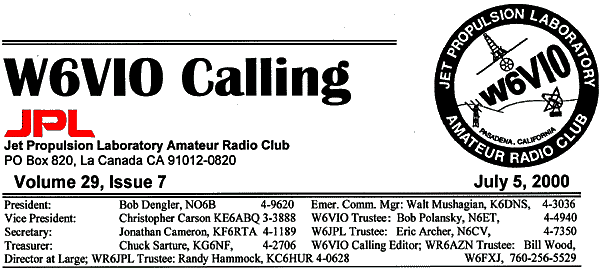
Permission to copy is granted provided that credit is given to “W6VIO Calling.”
Contents
Calendar of
Events
|
July 8 |
[Fontana
Swap Meet, A. B. Miller HS, Fontana} |
|
July 12 |
General
Meeting, Noon - 238-543 |
|
July 15 |
[CMRA
Hamfest, Cal Poly, Pomona, 7 AM] |
|
July 26 |
Board
Meeting, Noon - 233-305J |
|
July 29 |
[TRW
Swap meet, Redondo Beach] |
|
August 9 |
General
Meeting, Noon - 238-543 |
|
August 12 |
[Fontana
Swap Meet, A. B. Miller HS, Fontana} |
|
August 19 |
[CMRA
Hamfest, Cal Poly, Pomona, 7 AM] |
|
August 23 |
Board
Meeting, Noon - 233-305J |
|
August 26 |
[TRW
Swap meet, Redondo Beach] |
|
September 9 |
[Fontana
Swap Meet, A. B. Miller HS, Fontana} |
|
September 13 |
General
Meeting, Noon - 238-543 |
|
September 16 |
[CMRA
Hamfest, Cal Poly, Pomona, 7 AM] |
|
September 27 |
Board
Meeting, Noon - 233-305J |
|
September 30 |
[TRW
Swap meet, Redondo Beach] |
Meeting Notice
By Christopher Carson KE6ABQ
The July General meeting
will be held July 12th at noon in 238-543. This year’s Field Day operation will be reviewed, including lessons
learned, preliminary scores, and finances.
We need a volunteer to take
over the off-lab mailing of the printed edition of this fine document each
month. The task involves receiving the
extra printed issues from Xerox, and then folding, stapling, stamp application
and, most important, mailing the issues in a timely fashion. Pass the word around and hopefully we can
find a club member (or members – many hands, etc.) who can do this each month.
The June JPLARC Board meeting will be held July 26th in 233-305J. Everyone is welcome to attend – bring your lunch if you want. n
Prez’ Mix
By Bob Dengler,
NO6B
June was an
exceptionally busy month for me. It
started with a long trip to Rochester, NY to visit my brother Tom, N2XCX. After flying into Newark NJ, we spent the
first night in Stroudsburg PA in the Pocono Mountains, where it just so
happened that a manufacturer of a newly discovered 2-port repeater controller
was found. It sells for about half of
what the typical 2-port controller goes for these days yet has more features.
We met up with
Tom Walsh WN3L, who makes the MP-100 repeater controller kit, to chat for an
hour. Turns out that Jeff DePolo, WN3A,
conceived many of the features of his controller. Jeff is probably the most knowledgeable person in the country
with respect to amateur repeaters. He’s
built a system of about two dozen 440 MHz systems in the Pennsylvania and New
Jersey area, carefully skirting around New York City (as the local coordinating
councils also do).
In using his system, I must say that it’s the first system of multiple
linked repeaters I’ve heard that sounds BETTER than Cactus! Judicious use of
true FM G.E. radios and broadcast-quality audio processors account for the
superior audio quality of the system.
And all the systems are OPEN. If
you’re ever in that area, give it a try; check it out at http://www.offto.com/n3kz. BTW, the “repeater etiquette” and “usage
problems” pages at this web site are certainly worth reading as they really apply
to just about all amateur repeaters.
Driving north
through Pennsylvania into New York State, we approached our final destination
of Rochester. Since my brother moved a
couple of blocks since my last visit, I wasn’t sure exactly how to get there. So we arranged to meet on the widest
coverage local repeater, the KE2MK Xerox system. Unfortunately, I didn’t bother to ask my brother to check if it
was on the air; it was hit by lightning two weeks earlier.
Luckily, I was
able to get close enough to my brother’s QTH to use “reverse-pair simplex” so I
could communicate directly with him while he remained on 145.29 (-). We arrived in town just in time to attend
the A.R.R.L. Atlantic Division
Convention and Rochester Hamfest, only 20 minutes from my brother’s home.
While the convention portions of the Hamfest (exhibits and talks) were
not much to report on, I’d rate the Hamfest as halfway between TRW and
Dayton. On Saturday the Hamfest peaked
to about double the size of TRW, but the “quality” was better (more radio
stuff, less commercial vendors, computers and “junk”). There was even the proverbial “stack of
Mastr IIs” (commercial UHF mobile radios suitable for repeater use: our club
uses them for our 147.15, 445.20 and 447.20 repeaters).
It was at the
Hamfest, however, that it finally hit me as to how dismal the local repeater
situation was: I couldn’t find ANY repeater that would provide HT coverage from
the Hamfest to my brother’s QTH near Lake Ontario. With the Xerox repeater down and the local Rochester Radio
Repeater Association’s K2RRA repeater in poor condition, there wasn’t much else
available that worked.
So I found some coax and a low-gain base station antenna at the Hamfest
and we set up a 2-meter base station at the N2XCX QTH. Now we could use simplex to talk all the way
into downtown Rochester, or use the RRRA repeater to talk a bit further. It was really frustrating to use the K2RRA
repeater, as the only thing wrong with it was that the squelch on their
PL-110.9 remote receiver was set too tight.
I tried e-mailing the tech for the system, Bob N2HJD, about the simple
problem. His response was that the
squelch was set to accommodate “band conditions”. What the heck does that mean? The receiver is already PL’ed;
there was no reason whatsoever to run a tight carrier squelch except to
frustrate users.
Oh well, at
least my brother and his wife, KB2YHD now can talk simplex on their “private”
simplex frequency of 147.555. Well, it
was private until field day, when several local stations barged into their
Sunday morning QSO forcing them to give them FD points. I was wondering how W2RDX scored so high in
the FD listings year after year...
After the
Hamfest, we spent 3 days at Niagara Falls on the Canadian side. This marked my first ham operation outside
the U.S. I was sure glad we took the
radios along during this trip as I was given the task of finding groceries one
evening while my wife and daughter relaxed at the hotel.
We used a local 2-meter repeater in the town of Thorold: VE3RAF on
145.19, PL-107.2. While my wife was
reading off the list of things to get and I was frantically searching for any
kind of store, a local ham broke in and told me exactly where to find all the
major grocery stores. Try THAT with a
cell phone!
By the way, the
only repeater I found that was located right at the falls was VE3RNR on 443.175
(+), also PL-107.2. It’s amazing how
many systems have now gone to CTCSS access across the country.
Speaking of
Field Day, it was great seeing all of you up on Mt. Gleason this year. It was especially good to see the return of
Chefs Manny and Richard, KC6ZSY and KE6BKE, and Bill, W6FXJ (whose multitude of
pictures adorn this issue).
Thanks to the
group from the JPL Space Exploration Post 509 who manned the satellite station,
Sunday’s station breakdown and pack up was the fastest ever, making Field Day
so much more enjoyable for everyone.
I’m not sure whose idea it was to invite them up for the weekend, but it
turned out to be just as brilliant as collaborating with the Caltech ARC.
I think this
year’s FD was the BEST ever! Thanks again to everyone for making it so. This month (actually July 2nd)
closed with a “bang” on 6 meters, when a strong opening to Oregon and
Washington lasted for over an hour, resulting in full quieting signals on
52.525 FM simplex.
If you have a
6-meter mobile or base or even just one of the VX-5 HT’s, you might just try
leaving it on 52.525 in the late afternoon or evening. My first contact with N7JKQ in Medford was
made with only 10 watts on a ½ wave. ¾
June Club Meetings
By
Jonathan M. Cameron (KF6RTA)
General
Meeting, June 14
The
meeting was opened at 12:05 by Chris Carson.
A quorum was achieved. Those
present included Manuel Caldera (KC62SY), Jonathan Cameron (KF6RTA), Chris
Carson (KE6ABQ), Warren Dowler (KE6LEA), Robert Francis (KD6AMI), Randy Hammock
(KC6HUR), Jim Harris, Jay Holladay (W6EJJ), Rick McKinney (KA6DAN), Walt
Mushagian (K6DNS), Bob Polansky (N6ET), John Repar (WA6LWD), Phil Smith
(WA6LQP), Michael Tope (W4EF), Gary Warnick (KE6JZS), and Bill Wood (W6FXJ).
Gary Warnick and
Jim Harris were visiting from Goldstone and were welcomed by the club.
Bob Polansky
gave a detailed update on the plans for field day. He reviewed expected attendance, site layout plans, and the
check-off list. Although some help was
needed in a few areas, plans seemed to be going quite well.
Jay Holladay
announced that he planned to give a couple of sessions of training for the
logging program, CT.
Board of Directors Meeting, June 28
Those present
included Chris Carson (KE6ABQ), Bob Dengler (NO6B), Randy Hammock (KC6HUR), Jay
Holladay (W6EJJ), Walt Mushagian (K6DNS), Bob Polansky (N6ET), Chuck Sarture
(KG6NF), Bill Wood (W6FXJ, via telephone), and Jonathan Cameron (KF6RTA). A quorum was present.
There was a
general discussion of the field day exercise.
Most thought it went well.
However, we didn’t score as highly as expected for various reasons,
including moderate band conditions. We
basically broke even on food expenses.
We discussed
some improper contacts made by field day operators on 146.52 MHz. Some follow-up options were discussed.
We talked about
the possibility of operating PSK31 or QRP modes at the next field day. Next year we will have to get more help get
the trucks loaded up (on both ends).
Bob Dengler has
made contact with a 440 MHz repeater operator that should give continuous
coverage from JPL all the way to mount Gleason. We have permission to use the frequency next field day. ¾
DX News
By Bob Polansky,
N6ET
This month, the emphasis has been totally on Field
Day; therefore, I am relying totally on The 59(9) DX Report and the QRZ DX
Report for my DX news. Sunspot activity
has been good with a minimum of interruptions due to unruly solar flares and
the like. Lots of 50 MHz reports have
been showing up, but primarily in the European and African areas. Guess 50 MHz hasn’t yet developed the active
following that seems to exist on the other side of the pond. Non-the-less, 10 through 40-meter DX
activity have been substantial. Now for
a few specifics:
BANGLADESH - S21ZW or perhaps S21/AH8DX will be
active from 5 through 7 July. No modes
or bands were specified on this one.
CRETE - SV9/K7BV plans to be on the air from 27 June
through 3 July. He hasn’t been heard
yet on the 29th of June.
Keep your fingers crossed.
MONTSERRAT - Look for VP2MHX and VP2MHS from this
volcanic entity from 18 through 24 July.
Operation is planned on both SSB and RTTY.
MOZAMBIQUE - C91DC in active through the end of September. Look for him from 0500-0530Z on 28490-28495
kHz and from 1400-1500Z on 14245 kHz.
SAINT PAUL ISLAND - AI5P, KE1AC, WA4RX, and WV2B,
all /CY9 will put this QTH on the air from 6 through 10 July. They will be on 40 through 6 meters. For specific frequencies, look at the June 9th
issue of the 59(9) DX Report in the W6VIO shack.
SUDAN - ST0P (not STOP) is currently active from
this rare location. He will be there until August. He operates 40, 20,15, and 10 meters. Look for him from 1500-1800Z and from 0100-0400Z. Suggested frequencies are 14180 and 21180
kHz. Good luck on this one.
IARU CHAMPIONSHIP - If you’re interested in some
excellent DX competition, tune in to the fun on 8 through 9 July (starting at
1200Z and running for 24 hours). 53
stations in Slovenia will be active, each with different international teams
operating. It should be exciting.
Enough for this month. Gotta get some sleep to recover from Field Day! ¾
 |
|
Photos by W6FXJ |
Field Day
2000
Many things came together for Field Day 2000 to make it one of the most enjoyable events in our years of operating at Mt. Gleason. The weather was comfortable, the food was excellent, and for the first time in recent years we had sufficient help for both setup and teardown as well as during the 24 hours of on-air operation. In the words of FD Co-Chair Bob Polansky, N6ET, we had we had the “most spirited, helpful Field Day group ever assembled by the JPL and Caltech clubs”.
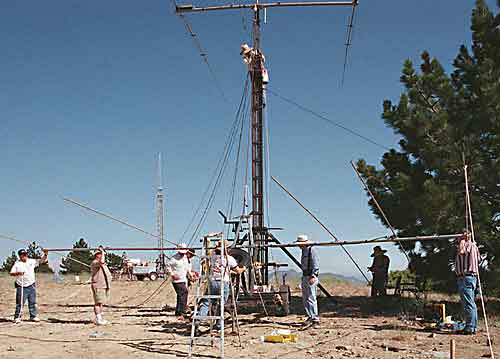 |
|
Lifting the five-element 15-meter Yagi |
Having plenty of help meant that we were able to
raise both tower trailers and install the beams on Friday. By that night all HF antennas for W6VIO were
installed, some stations were set up, and we were able to have a few checkout
QSO’s before getting some sleep. All
antennas and stations were operational by 11:00 AM Pacific Time on Saturday,
when the 24-hour operation began.
By the end of the contest on Sunday morning we had
racked up 3639 contacts, 1492 on CW and 2147 on phone. Since we were competing in Class 3A this
year, these numbers can’t be compared directly with last year’s, but our
projected point score (11,300 plus) would have been good for 10th
place nationally in 3A last year. All
of these numbers are approximate, since there are still a few manual log sheets
to be entered into the computer and dupe checks to be completed.
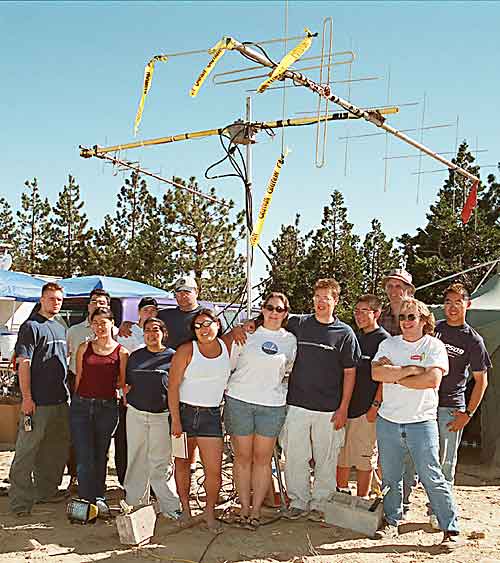 |
|
Rear: Benjamin Laube, Bernard Nazari, Andrea Winterstuf, Julien Schubert, Ken Fisher, Jay Holladay, Matthew Tsang. Front: Danielle Murray, Vijali Brown, Jennifer Song, Kelly Winters, Ben Solish and Mike Tope. |
The
Explorers from JPL Post 509 added a new note of enthusiasm and excitement on
the mountain. By setting up and operating
the satellite station they also contributed 5 satellite QSO’s and a bonus of
100 points to our efforts. Their
willingness to help with Sunday afternoon teardown of our setup was greatly
appreciated.
Special
thanks to Tigran Karsian, KF6PVG, and the adult leaders and members of Post 509
who contributed to this effort. Kudos
also to Mike Tope, W4EF, for arranging for participation by the Explorers,
mentoring them on amateur satellite operation, and collecting the station
equipment.
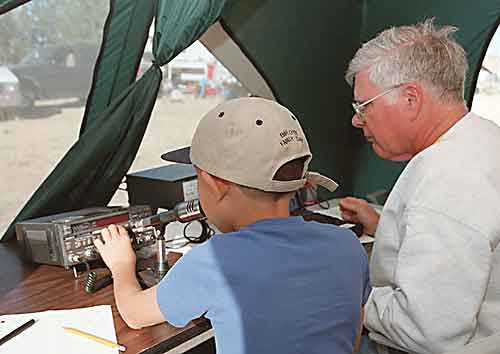 |
|
Steven Sander, mentored by Merv MacMedan, N6NO, makes some contacts in the Novice/Tech tent |
Some of the newer hams and would-be hams got to try
contest-style operation while being mentored by the experienced types, and this
worked out well for all concerned. With
ten meters being hot all day and into the evening, our Novice/Tech Plus station
garnered about 160 QSO’s. Now, will
some Tech Plus volunteer to try a few CW contacts next year? You will have
plenty of “Elmers” to help you build your CW skills before next June!
 |
|
Jay Holladay greets Explorer Scouts at the FD Visitor’s Booth |
Our booth for explaining amateur radio to visitors
was done very professionally by Bill Wood, W6FXJ. Our idea of having everyone on site post their QSL card as part
of this display was a last-minute effort, and we could have used more
cards. Please remember to bring a QSL
next year!
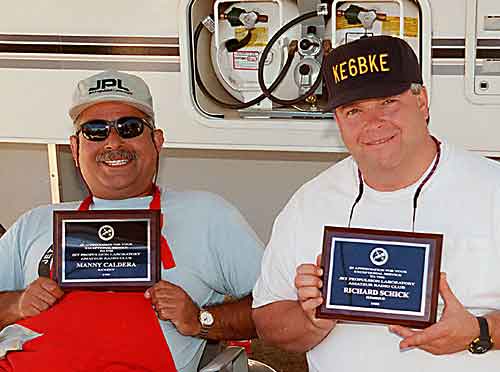 |
|
Manny, KC6ZSY, and Richard, KE6BKE after receiving Field Day Meritorious Service Awards |
The people comforts were also first class. We were again fortunate to have Manny
Caldera, KC6ZSY, as our chef du Field
Day, ably assisted by Richard Schick, KE6BKE. Plenty of food and drink kept the operating staff happy, and
having “almost enough” operators meant that some people actually got some sleep
on Saturday night.
All in all it was a great effort. Our setup of antennas and tents worked out
quite well and we will build on it for next year. We would like to find a way to simultaneously operate phone and
CW (or digital) on the same frequency band next year. We really should get someone to bring a PSK31 setup and try
running up some contacts in the digital mode.
And, we want to network the computers to avoid logging problems if we
have contacts on the same band/mode from more than one tent. We solicit more ideas on how we could
improve our setup for next year.
A complete listing of our contact totals and score
will be provided in the Field Day wrap-up in next month’s W6VIO Calling.
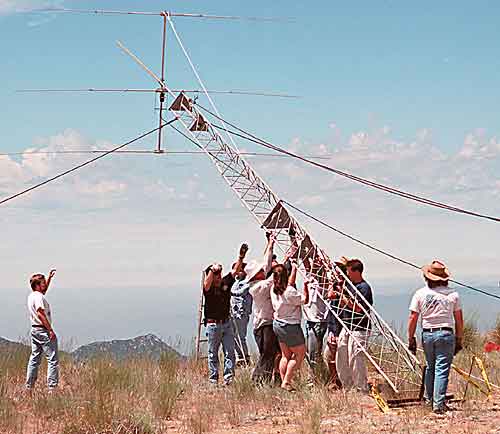 |
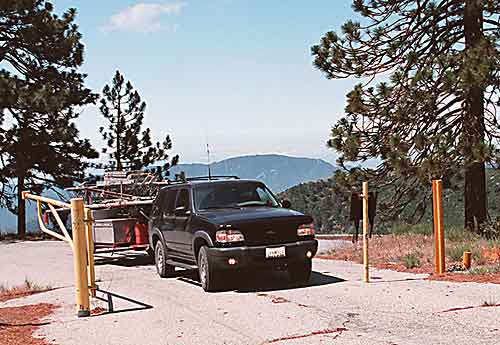 |
 |
 |
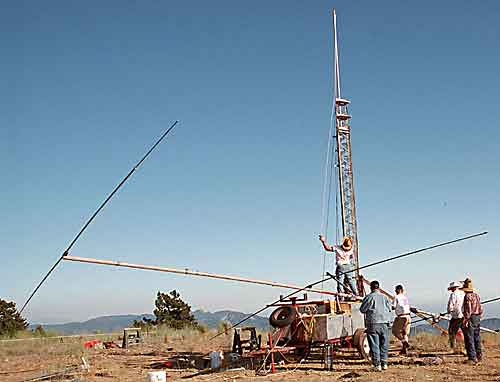 |
|
Getting Ready to lift the 20-meter beam |
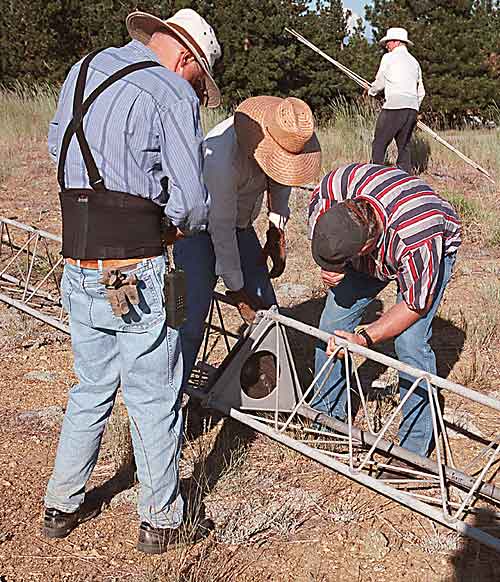 |
|
Assembling the 6/10-meter Beam Antenna Tower |
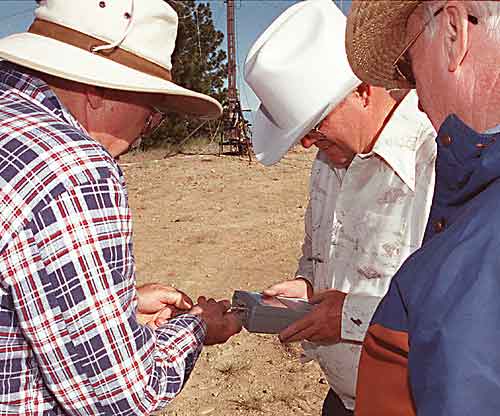 |
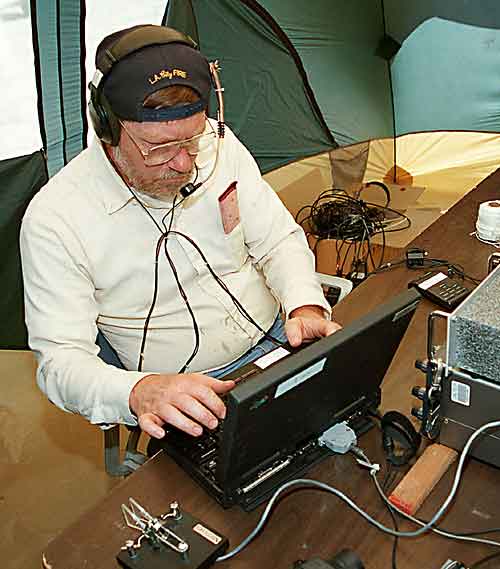 |
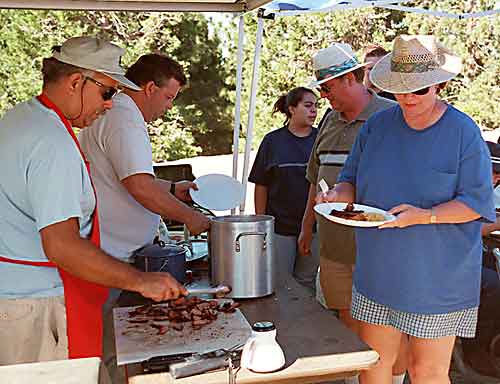 |
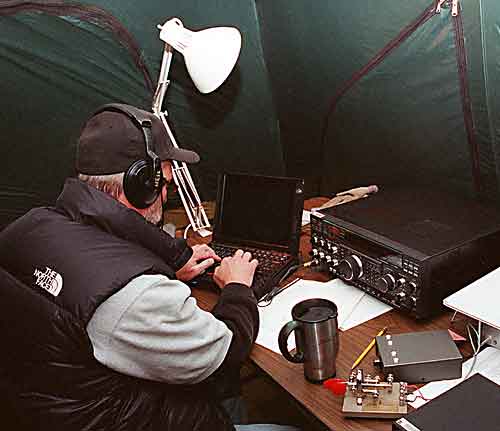 |
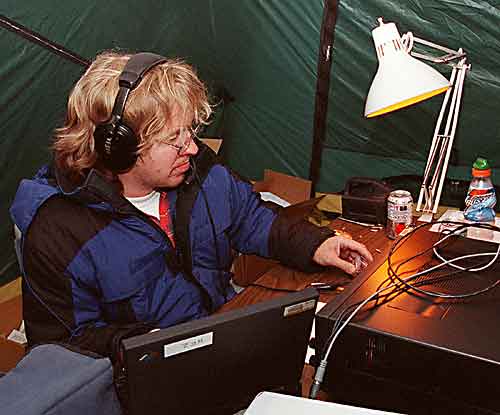 |
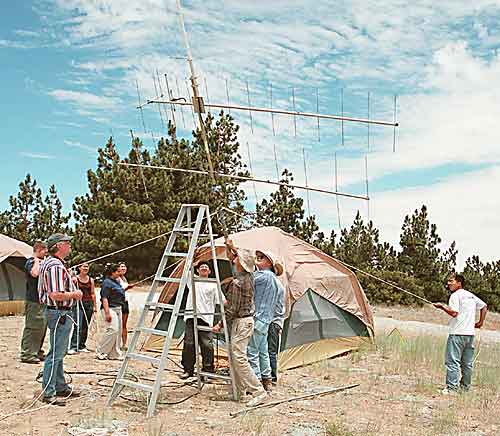 |
|
Newsletter Deadline: Friday, July 28 for the August issue of W6VIO Calling. Your articles, ads, photos, diagrams, letters to the editor, or technical material should be submitted to the editor via email (w6fxj@earthlink.net) or regular mail to: Bill Wood, 31094 Hemlock Ave, Barstow, CA 92311. |
|
JPL ARC Repeaters |
|||
|
Pasadena: |
|||
|
WR6JPL |
147.15 MHz |
(+) |
PL
131.8 Open Shuttle Audio |
|
WR6JPL |
224.08 MHz |
(–) |
PL 156.7 Open |
|
WR6JPL |
224.70 MHz |
(–) |
Closed Autopatch |
|
WR6JPL |
445.20 MHz |
(–) |
PL 103.5 Open |
|
W6JPL-1 |
145.09 MHz |
|
Packet Node/BBS |
|
W6JPL-1 |
223.54 MHz |
|
Packet Node/BBS |
|
Table Mountain: |
|||
|
WR6AZN |
145.28 MHz |
(–) |
PL 131.8 Open |
|
WR6AZN |
223.96 MHz |
(–) |
PL 156.7 Open |
|
WR6AZN |
447.20 MHz |
(–) |
PL 94.8 Open |
Posted July 6, 2000







